Dewsbury, Batley and Birstal Tramway
History
This 4.29-mile, standard-gauge tramway was a locally financed concern that began life with the formation of the Dewsbury and Birstal Tramway Company on the 13th November 1872, though it subsequently changed its name — on the 16th April 1873 — to the more accurate Dewsbury, Batley and Birstal Tramways Company (note the anachronistic spelling of Birstall).
The company obtained powers to build a horse tramway on the 28th July 1873, construction beginning in early 1874. The first section, between Dewsbury and Batley, opened on the 25th July 1874, further sections following in 1875, together with an extension to Gomersal in September 1875, which brought the system to its final size. The tramway was constructed on the single line and passing loop principle, and ran from a terminus in Northgate in Dewsbury, northwards along Bradford Rd to Batley, where it turned northwestwards, passing through Carlinghow and Birstall to a terminus at Gomersal.
The following year the company began looking at steam locomotion, a form of traction which had yet to make its debut on a street tramway in the British Isles, but which many believed would drastically cut operating costs, not to mention spare the horses, this being a particular concern in the locality — the Heavy Woollen District — which had many steep hills. Although trials were conducted in 1876, it was to be four years before regular services would commence, on the 10th April 1880. This was in fact the first use of steam traction on a street tramway in England, following the passing of a General Act in 1879 permitting the use of mechanical traction on tramways. At first the steam and horse services were interspersed, but the speed and power differential soon led to operational difficulties, which no doubt meant flogging the horses in an attempt to keep to schedule. Further engines were therefore ordered, and when delivered (in 1881), they displaced the horses, just a single animal being retained to help with depot shunting.
The tramway appears to have been well-maintained and efficiently operated, paying reasonable dividends right through to the mid 1890s when they began to drop off. Under the Tramways Act of 1870, the local authorities were entitled to purchase the portion of the tramway within their respective boundaries after 21 years, and at 7-year intervals thereafter. The authorities showed no interest in purchasing the tramway at the first of these dates (1894), but by 1900 they had decided to exercise their option at the next available opportunity, which fell in 1901. Although the DB&BTCo attempted to resist having its tramway municipalised, there was absolutely nothing it could do to stop the councils exercising their legal right.
Meanwhile, another player — the British Electric Traction Company — had arrived on the scene. Since the late 1890s, the BETCo had been aggressively purchasing horse and steam-operated tramways with the intention of converting them to electric traction, as well as promoting schemes for completely new electric tramways; it would in fact go on to either own, part-own or lease over 50 tramway systems across the British Isles. The BETCo now struck a deal with the local councils in which the latter would notify the DB&BTCo of their intention purchase, but would eventually lease operation to the BETCo. This was all part of the BETCo's grand plan for the area, having separately promoted and acquired powers in 1901 — under two Spen Valley Light Railway Orders — to build a sizeable electric tramway system in the Heavy Woollen District.
The BETCo also turned its attention to the steam tramway company, a successful offer being made to its shareholders in late 1901, with control effectively passing to the BETCo on the 24th February 1902, when the DB&BTCo's directors and the manager all resigned in favour of BETCo appointees. Unfortunately, by this time, the BETCo found itself involved in an increasingly acrimonious dispute with Batley Corporation — over various matters — the latter also having held tramway powers of its own since 1901. The corporation commenced construction of its new lines in the middle of1902, and whilst the intention had always been to lease them to the BETCo, the continuing disagreements saw the corporation threatening to operate its own services, even ordering the tramcars with which to do so. Common sense ultimately prevailed, with the corporation agreeing to lease operation of its newly built lines to the BETCo, as well as withdrawing its objections to the company's application for powers to convert the steam tramway to electric traction (these were duly granted on the 19th August 1903).
The local authorities (Batley Corporation, Birkenshaw UDC, Birstall UDC, Dewsbury Corporation and Gomersal UDC) took possession of the steam tramway on the 7th June 1905, reconstruction commencing on the 10th July 1905 at the Gomersal end of the line and proceeding in sections. The last steam services are thought to have been withdrawn around the 26th September 1905, with electric services over the first reconstructed section — operated by the BETCo's subsidiary, the Yorkshire (Woollen District) Electric Tramways Company — commencing on the 28th September 1905.
Uniforms
Photographs of the Dewsbury, Batley and Birstal Tramway in its horse-drawn days (1874-1881) appear not to have survived, so it is impossible to know for certain whether uniforms were issued or not; however, given that they seem not to have been worn during the steam era, it is highly likely that horsecar staff simply wore smart but informal attire comprising trousers, jackets, and the fashionable headgear of the day, at that time no doubt the bowler hat.
The photographic record for the steam-hauled era (1880-1905) is fortunately extremely rich, and clearly shows that drivers wore railway footplate-like attire: cotton jackets and trousers, with cloth or heavy cotton caps; these bore no insignia. Conductors wore smart but informal attire, along with bowler hats, and later on, flat caps; no insignia or licence badges of any kind were carried. A single photograph (probably taken in the early 1890s) has, however, survived that shows a conductor wearing a kepi-style cap bearing a large oblong metallic cap badge with a semicircular protuberance on the top, the shape of which is very reminiscent of American railroad and streetcar practice. The fact that this cap and cap badge are only seen in a single photo out of dozens, suggests that it was either very short-lived or that the cap came with the employee from another system.
A single photo has survived showing an individual who may be an inspector (see below); all that can be gleaned, however, is that the individual would appear to be wearing a uniform, though what style and what type of cap cannot unfortunately be discerned.
Surviving records show that at the end of 1903, the concern employed a total of 23 drivers and conductors, as well as 2 inspectors (see 'The History of the British Steam Tram Volume 3' by D Gladwin; Adam Gordon Publishing [2007]).
Further reading
For a history of the Dewsbury, Batley and Birstal Tramway, see 'The Tramways of Dewsbury and Wakefield' by W Pickles; Light Rail Transit Association (1980).
Images
Steam Tram drivers and conductors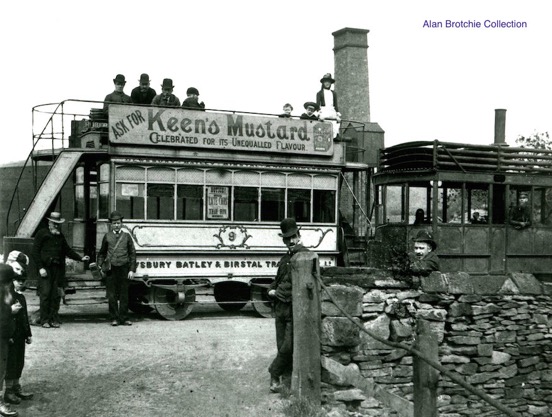
An unidentified Merryweather steam tram with Trailer No 9 — photo undated, but probably taken in the mid 1880s judging by the style of the hats.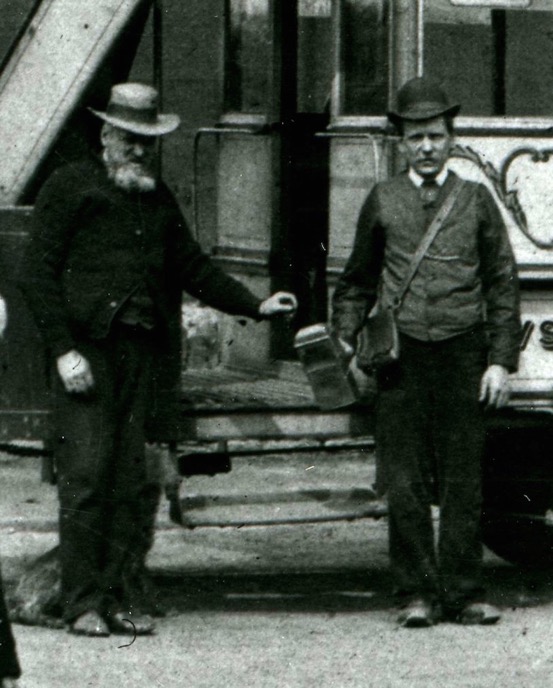
An enlargement of the above photograph showing the conductor, who is wearing smart but informal attire, and is participating in a demonstration of the Kayes 'Patent' Fare Box.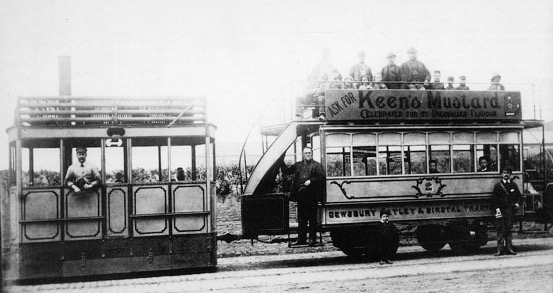
A Merryweather steam tram and Trailer No 2 (a converted horsecar) — photo taken around 1885. Photo courtesy of the Tramways and Light Railway Society, with thanks to David Voice.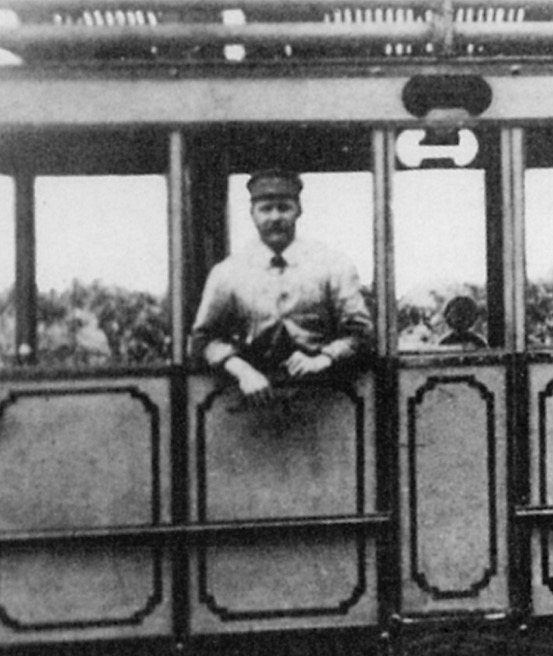
An enlargement of the above photograph showing the driver, who is wearing railway footplate-like attire.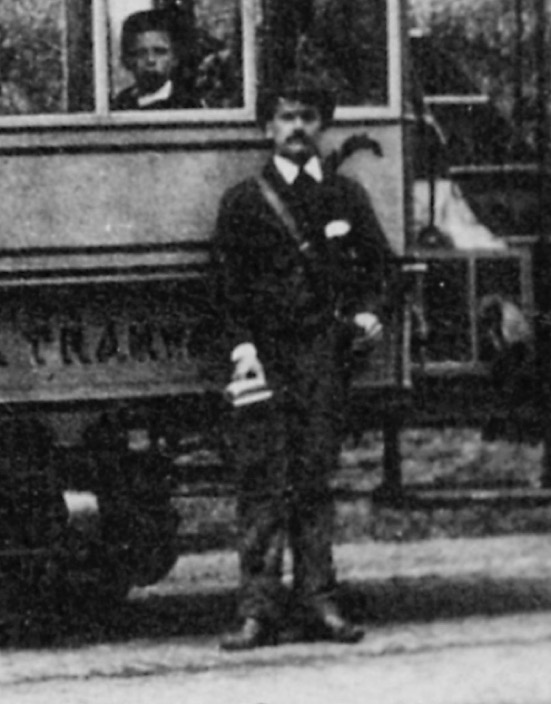
Another blow-up of the above photo, this time showing the conductor. He is wearing informal but smart attire, with a bowler hat that is typical for the period, with upturned brim.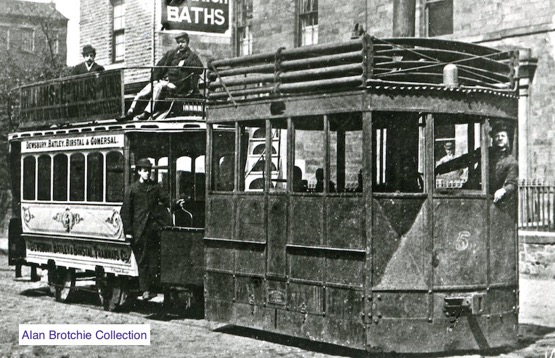
A somewhat battered Steam Tram No 5 and its much more presentable trailer (No 3), an ex-horsecar — photo undated, but probably taken in the late 1880s (all the engines of this class had been withdrawn by 1893).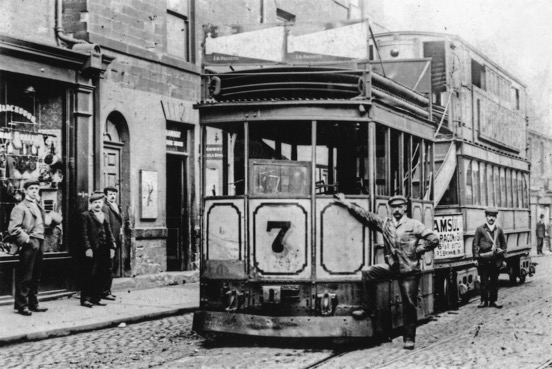
The driver and conductor of DB&BTCo Steam Tram No 7 pose for the cameraman at the Northgate terminus in Dewsbury in 1891.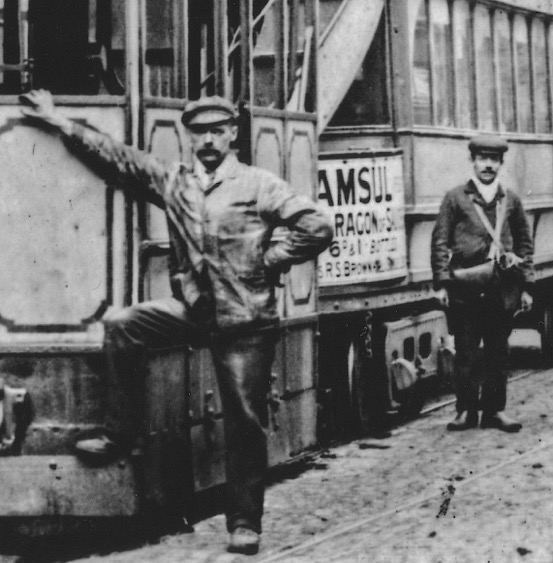
An enlargement of the above photograph showing the crew. The driver's clothing more than adequately betraying the filthy nature of the work.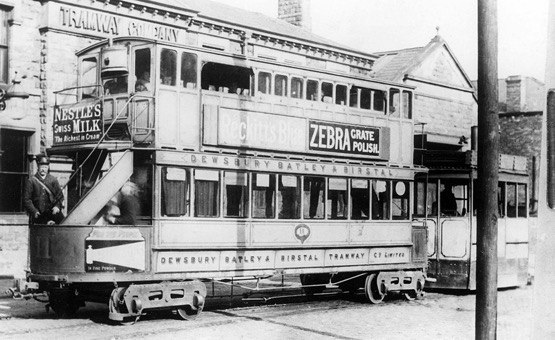
Trailer No 11 of 1886 stands with an unidentified Merryweather engine outside the depot at Carlinghow in Batley — photo undated, but probably taken in the early 1890s. Photo courtesy of David Gladwin, with thanks to Trevor Preece.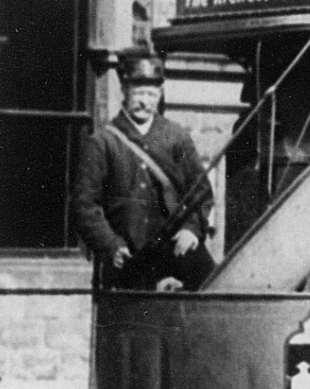
A blow-up of the above photo showing the conductor. He is clearly wearing a kepi-style cap that bears a large oblong cap badge with a semicircular top, reminiscent of those used by two neighbouring tramways: the Bradford Tramways & Omnibus Co and the Leeds Tramway Co. He is also wearing what may be a uniform jacket, though it is difficult to say for sure.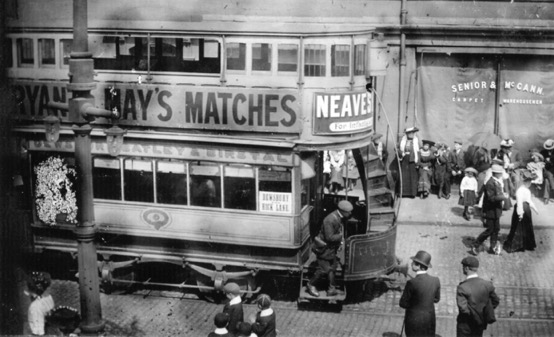
A busy street scene showing Trailer No 6 in Northgate, Dewsbury, with the conductor hanging from the rear platform — photo undated, but very probably taken late in the tramway's life, i.e., in the early 20th Century. Photo courtesy of the Tramways and Light Railway Society, with thanks to David Voice.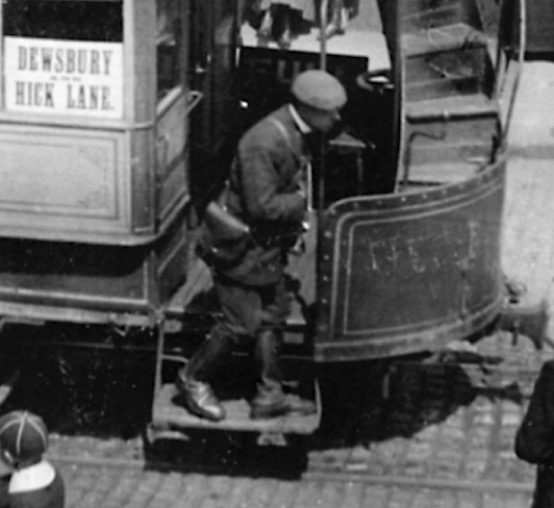
An enlargement of the above photograph, which clearly shows that the conductor is wearing informal attire.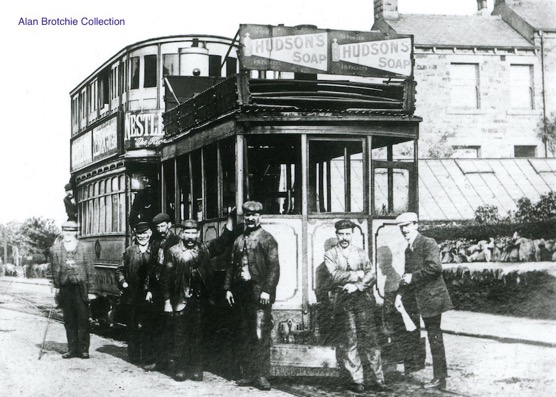
Several crews pose for the cameraman with an unidentified steam tram and a noticeably 'hogged-backed' trailer, suggesting that the company were employing a 'make do and mend' approach to maintenance, and thus, that the photograph was probably taken very late in the tramway's life, probably in 1905.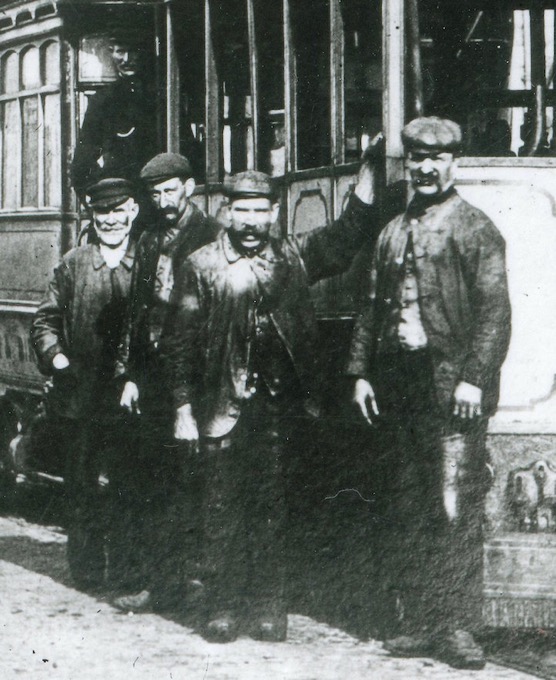
A blow-up of the above photograph showing four of the footplate men, all of whom can only be described as being incredibly filthy. It is possible, though far from certain, that the figure behind them, half in shadow, is an inspector.